Subscribe to ShahidulNews
Modern-Dance History Times Five, With Plenty of Theatricality
Julieta Cervantes for The New York Times
?
NEWARK ? It?s slightly astonishing that ?Fly: Five First Ladies of Dance? hasn?t had a longer season in the New York precincts since its premiere at the Kumble Theater in Brooklyn in May of last year. The women of the title are Germaine Acogny, Carmen de Lavallade, Dianne McIntyre, Bebe Miller and Jawole Willa Jo Zollar, all contemporary-dance royalty who direct schools and companies. Seeing them on a program together is like going to a female, modern-dance version of those all-star ballet gatherings like ?Kings of the Dance.? Only interesting.
?
Multimedia Slide Show ?Fly: Five First Ladies of Dance? Blog ArtsBeat The latest on the arts, coverage of live events, critical reviews, multimedia extravaganzas and much more. Join the discussion. More Arts News Part of that interest is that ?Fly? is a record of black women in dance over the last several decades. The women range in age from almost 60 to almost 80, and while their solos are mostly new, their dance styles, vocabularies and histories are resonant in every onstage gesture.
?
But ?Fly,? which was performed to a crowded and enthusiastic audience in the New Jersey Performing Arts Center?s Victoria Theater here on Sunday, is as unabashedly a theatrical event as it is a historical one. It wouldn?t matter if you had absolutely no idea who any of these women were; it?s a straightforwardly great show.
?
That?s not because of the choreography, which mostly takes second place to the drama of performance. Much of Ms. Miller?s ?Rain? from 1989, set to music by Hearn Gadbois and Heitor Villa-Lobos, takes place on the ground, where she rolls and curls, bends her torso and unfurls her hands like flowers, finally embracing the green refuge of a rectangular grass patch upstage.
?
She brings a riveting intensity to every small movement, and Ms. Acogny does the same on a larger scale in ?Songook Yaakaar (Facing up to hope).? An influential French-Senegalese choreographer, Ms. Acogny is a much-larger-than-life powerhouse whose solo begins with her entrance through the audience, chanting in a solid French accent, ?We need more female presidente in the world.?
?
I vote for Ms. Acogny. In ?Songook,? which takes a serious turn after playful beginnings, she moves with little bent-kneed walks, slow-motion running steps and subtle contractions of the torso. Her concentration is ferocious, her ability to draw us into her world prodigious.
?
The other women possess the same compelling interiority: a combination of personal charisma and the artful performance skill that comes from extensive experience. In ?If You Don?t Know…,? the resolutely elegant Ms. McIntyre offers an improvisational, jittery, stamping-legged dance set to music by Olu Dara, played by the pianist George Caldwell, and a recording of St. Clair Bourne.
?
The text concerns the difficulties facing black filmmakers, and while Ms. McIntyre provides witty physical illustration, her piece never veers into the polemical. Neither does Ms. Zollar?s ?Bring ?Em Home,? in which she moves from exhausted despondency to hip-shaking, tap-footwork joy, the political subtexts of African-American experience remaining quietly nuanced.
?
Last came Ms. de Lavallade, regal in a long red dress, performing ?The Creation,? a 1972 solo by her husband, Geoffrey Holder. Set to a poetic reinterpretation of Genesis by James Weldon Johnson, the solo shows Ms. de Lavallade?s compelling theatricality and gift for humor, and the gestural beauty of her arms and hands. It?s a great ending, but for one quibble: Why exactly would a program celebrating the gifts of these glorious women end with a paean to the creation of man?
Relating Article: Dancing Amidst the Baobabs
american War Par Da
Funny until you realise how serious it is
Funny until you realise how serious it is
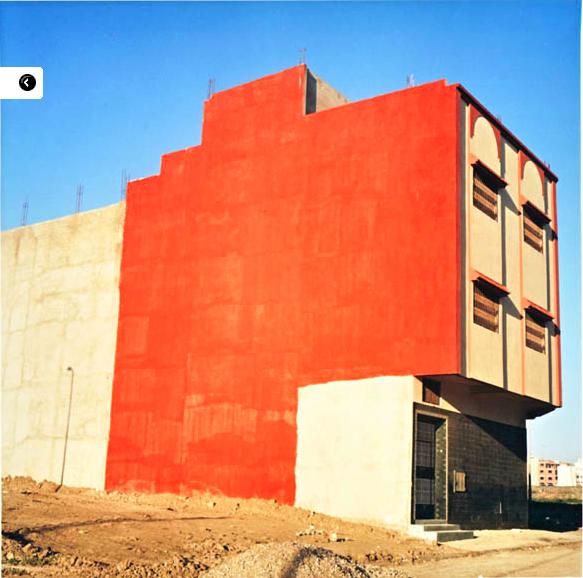
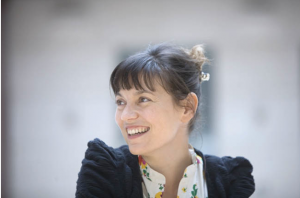
Yto Barrada
Deutsche Bank's Artist of the Year 2011
Yto Barrada is Deutsche Bank's "Artist of the Year" 2011. On the recommendation of the Deutsche Bank Global Art Advisory Council, consisting of curators Okwui Enwezor, Hou Hanru, Udo Kittelmann and Nancy Spector and chaired by Pierre de Weck, member of Deutsche Bank AG's Executive Committee, the bank honors young artists who have already created an extraordinary oeuvre in which works on paper or photography play an important role. As "Artist of the Year," Barrada will be presented in a comprehensive solo exhibition at the Deutsche Guggenheim in Berlin from April 15 to June 19, 2011, which will subsequently be shown at other international institutions. Unlike many other prizes, the "Artist of the Year" award does not include prize money, but is firmly embedded in Deutsche Bank's art program, with which the bank has made contemporary art accessible to the public worldwide for 30 years. An extensive publication will accompany the exhibition and Barrada will realize an exclusive artist's edition for the show in Berlin. In addition, the bank is acquiring a selection of works on paper by the artist for its collection. After Wangechi Mutu in 2010, Yto Barrada is the second artist to be named Deutsche Bank "Artist of the Year." As of the end of 2010, an entire floor of the bank's modernized corporate headquarters in Frankfurt will be devoted to her work. Barrada's work ? photographs, films, publications, installations and objects ? reflects the peculiar situation of her hometown, Tangier, and the way notions of local and global are articulated there. At the northern tip of Morocco, Tangier is a city of several frontiers. One border is the Strait of Gibraltar: the 13 km wide stretch of dangerous currents which divides Africa from Europe has come to symbolize the odyssey of the immigrant, and the existential issues of a society dominated by a desire to leave. Another frontier of this fast-growing city of a million souls runs along its shifting outer edge, where new construction meets the landscape of northern Morocco. There, a quieter drama is played out as the diversity of local people and wildlife yield to the bulldozers and concrete trucks, and the monocultural vision of the planners and developers who command them. The work of Yto Barrada resists any simplification of the context of immigration ? that great European "issue" ? on the globalized world. In the photo series "A Life Full of Holes: The Strait Project," which she began in 1998, the artist portrays the city and its residents in a kind of everlasting waiting state. The suspended expectation of the people relates at the same time to their personal imaginary, to the ancient myths of remission and death, as well as to the present geographic and political situation. Her recent project, "Iris Tingitana" has extended Barrada's inquiry to the landscapes that surround Tangier. These works records the shifting border between city and nature, and the accompanying homogenization of the country's urban and botanical surfaces. Barrada grew up between Tangier and Paris, where she studied history and political science at the Sorbonne, and subsequently attended the International Center of Photography in New York. Her practice, combining the strategies of documentary with a more meditative approach of images drove her to return home, after sixteen years abroad. There, she continues to explore the many levels of a complex reality, avoiding the rigidity of any discourse, and without showing any dramatic event. Barrada's work evokes a Tangier where postcolonial history has materialized one of its dead-ends. And another response of this artist to the dynamics of the region was to co-found the Cin?math?que de Tanger, North Africa's first cinema cultural center, which she now directs. The Cin?math?que offers another way to invest herself into the status of images and representations, specifically in the Arab world. "A main focus of our global art activities is to engage with different cultures and social realities. Yto Barrada is therefore an excellent choice as 'Artist of the Year 2011'," said Pierre de Weck. More information at db-artmag.com.
Book Launch: "The Boy Who Wanted to Fly" Phoenix Artist Club.
1 Phoenix St. London WC2H 0DT
6:30 pm 13th October 2010
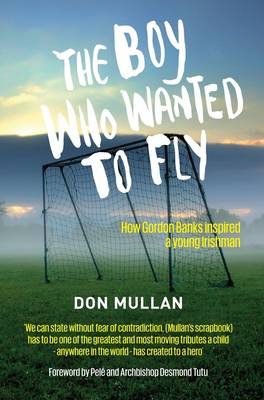 Angered by the events of Bloody Sunday the young man had wanted to join the IRA. But Don Mullan found other ways to seek justice. Having stumbled across documents that recorded eye witness accounts of the event, in an attic in a lawyer's office, Don went on to force a reopening of the case. His best-selling book Eyewitness Bloody Sunday, is a gripping account of the story. The dyslexic boy had a hero. The great English goalkeeper Gordon Banks. Like so many young men who had been enchanted by the 1966 World Cup winning goalkeeper, Mullans meeting with Banks in Ireland in 1970 was to change the course of his life. He rejected violence, and the Irish boy went on to build a monument to his English hero. Don Mullan is one of the most colourful characters I have ever met. Sitting in his back garden in Dublin, Paddy Maguinnes, Don and I have had wonderful times talking about his discovery of the documents in a lawyer's attic, his humorous pursuit of Nigerian scammers who got more than they bargained for when they had asked for his money, his global mobile photography projects and of course his incredible ability to make impossible things happen. The monument to Gordon Parks and Pele's visit to the monument. The new book by Don "The Boy Who Wanted to Fly" is about paying homage to a hero, but much more about how individual acts of greatness can have such profound effects on individual lives. The book has a joint four-page foreword by Pel? and Archbishop Desmond Tutu.
Angered by the events of Bloody Sunday the young man had wanted to join the IRA. But Don Mullan found other ways to seek justice. Having stumbled across documents that recorded eye witness accounts of the event, in an attic in a lawyer's office, Don went on to force a reopening of the case. His best-selling book Eyewitness Bloody Sunday, is a gripping account of the story. The dyslexic boy had a hero. The great English goalkeeper Gordon Banks. Like so many young men who had been enchanted by the 1966 World Cup winning goalkeeper, Mullans meeting with Banks in Ireland in 1970 was to change the course of his life. He rejected violence, and the Irish boy went on to build a monument to his English hero. Don Mullan is one of the most colourful characters I have ever met. Sitting in his back garden in Dublin, Paddy Maguinnes, Don and I have had wonderful times talking about his discovery of the documents in a lawyer's attic, his humorous pursuit of Nigerian scammers who got more than they bargained for when they had asked for his money, his global mobile photography projects and of course his incredible ability to make impossible things happen. The monument to Gordon Parks and Pele's visit to the monument. The new book by Don "The Boy Who Wanted to Fly" is about paying homage to a hero, but much more about how individual acts of greatness can have such profound effects on individual lives. The book has a joint four-page foreword by Pel? and Archbishop Desmond Tutu.
Full Disclosure by Brian Palmer
Big Sky Film Fest
Full Disclosure Moves War Films Forward
By Stewart Nusbaumer
Missoula, Montana -- After seven and nine years of war in Iraq and Afghanistan we now have several dozen films on these conflicts. The majority focus on the everyday lives of US troops, conveying an intimidate view of their combat environment, a comprehensive slice of life in the combat zone. And these films tend to avoid the politics of the war. It's the nitty-gritty on the ground while avoiding the morality of the wars. Restrepo, which recently took the documentary honors at prestigious Sundance Film Festival, chronicles a US Army platoon in dangerous Korendal Valley in eastern Afghanistan. The doc also remains outside artillery range on morality. Full Disclosure, which screened last night at the Big Sky Documentary Film Festival -- the 7th year for this increasingly prestigious docs-only festival -- likewise focuses closely on the lives of American combatants. The director, Brian Palmer, embedded three times with US Marines in Iraq from 2004 to 2000. He shows Marines slogging through the mud, Marines barging into the houses of Iraqis, Marines in several fire fights, Marines ecstatic to return home, and Marines stoic when returning to Iraq. This documentary, however, is not only about our troops in Iraq, but also about the filmmaker in Iraq. Brian Palmer places himself squarely in his film. As the Marine's war moves forward, his voice in the film grows stronger and stronger. Although different from other recent war films, the difference is not overpowering, not a radical departure in any way. The difference is rather subtle, the difference slowly unfolds. At the heart of this film is this: the conflict of the Iraq War is also the filmmaker's conflict. One the one hand, Palmer is a close friend of the Marines. He clearly has a touch of a wannabe, and over time and trial he bonds with the Marines. He even visits some at their homes outside of Camp Lejeune in North Carolina. On the other hand, Palmer is an independent journalist. He is different from the younger Marines. And Palmer knows getting too close to the Marines can be costly for Palmer the investigative journalist. The military embedding process narrows the distance between soldiers/Marines and journalists. The system is designed to have journalists identity with who they are covering, and write from their perspective. To write with the sensitivity and interests of our combatants foremost. For Palmer, this is the struggle. He is being pulled toward his Marines and is being pulled to maintain some distance from the Marines. There is never an easy solution to being pulled in both directions. Still, the product,?Full Disclosure, is fair to the young Americans on the front line in Iraq and to the principles of fair journalism.
Palmer, however, and this is clear, does not support the Iraq War. Yet he does not wield a big moral stick. His antiwar mindset is mostly implied, discernible but not blatant. Still, it's there. There is a moral voice in this war zone, which I liked -- although some viewers may not. Full Disclosure, then, moves onto ground that other war documentaries are mostly avoiding. Placing himself in the film, his voice persistent throughout the film, his uneasiness growing stronger, his beliefs seeping through, his opposition to this unpopular war there, the "I" is back in war. Full Disclosure may be a push for American war films to move in a new direction -- insightful and fair to our fighting troops, while also revealing of the filmmaker. This is an interesting, fair film. See?Full Disclosure.
SONGOOK YAAKAAR
New solo work of Germaine Acogny
(Facing up to hope)
THE PREMIERE AND TOURING
Germaine Acogny 10th of September 2010 Pre-premiere / Festival Oriente Occidente / Rovereto / Italy 17th and 18th of September 2010 * Premiere / Biennale de la Danse /Th??tre de la Croix-Rousse / Lyon / France 22th of September 2010 Bozar / Bruxelles / Belgium 7th, 8th, 9th, of October 2010 Pavillon Noir / Aix en Provence / France 13th, 14th, 15th of October 2010 CND / Paris / France 12th of November 2010 Tanzhaus NRW/ D?sseldorf / Germany 15th of November 2010 Murcia / Spain (to be confirmed) * For friends who would like to come to Lyon, they will get preferential rates => take contact with Sandrine Julien +33(0)4 27 46 65 60/ sjulien@biennale-de-lyon.org (in the limit of available seats) Jant-Bi Toulouse/SEBT du 3e Monde 24 rue l?once castelbou 31000 TOULOUSE tel: 0561231775 / 0950715957 fax: 0955715957 www.jantbi.org Related link
Otondro
By Naeem Mohaiemen opens in Germany
"Otondro Prohori, Guarding Who", which premiered at Chobi Mela V in Dhaka, will next show in Germany. It will be in "Trust" at Dortmunder, part of the 2010 ISEA (International Symposium on Electronic Arts). Otondro was part of a project on militarization and surveillance, which included "My Mobile Weighs A Ton". Back to elections. Back to democracy. The new normal. Mission accomplished. But the residues are still here. A temporary camp for highway construction. Phantom investor. New chairman. List of approved guests. Shadow falls. A theorist talks about the architecture of occupation, hollow land. But security presence in Asia is subtle. Suit tie coat bideshi degree. Think tanks, seminars, conferences, talk shows, newspapers. Everyone has an opinion on the century's obsession. War against an invisible enemy. They tell us, we know all the answers. How to catch them, inside and outside borders. How to keep them out. Facial hair, surname, skin hue, city of birth, passport - the full spectrum domination of motivation recognition. It's not who you are, it's who we say you are. Dhaka is now inside a security zone bubble. Will democracy remove the steel wire barricades and midnight checks on Dhanmondi Bridge? On the day after the state of emergency was lifted, I saw a homeless woman drying her family clothes on that same wire barricade. A sweet, fleeting moment. But a few days later, the barricades were back in action. The demand for ID, the sudden stop and search, the rummaging inside your camera bag, the interrogation. Eto raat e beriyechen keno? Janen na din-kal kharap? I feel a searing nostalgia for open space, a time before these "temporary" structures. Temporary camps that never leave. It's all to make you safe and secure. Safe from what? A long pause. Yourself, your weaker side, your politics, your affiliations, your nightmares, your ideology, your rights, your friends and neighbors. Your dreams.
Pakistan's Parliament Full of Fake Degree Holders
By Isa Daudpota
Starting in the second quarter of this decade I wrote almost 20 articles highlighting institutions and the fake degree holders who held high positions in Pakistan. The Chairman of Pakistan's Higher Education Commission (HEC), Dr Atta-ur-Rahman was provided evidence about people and institutions that were involved in this racket. He and the HEC turned a blind eye to the problem. The Election Commissioner did the same; he failed to respond to my two letters that asked for all parliamentarians be asked to have their degrees verified by the HEC. This appeal has been repeated in a recent joint letter that friend Naeem Sadiq and I wrote to both the Supreme Court and the Election Commissioner. Neither has so far responded. The lack of responsiveness of the courts to public interest issues and the emasculation of their power by successive governments is a key impediment to Pakistan's progress. Today the issue has come to a boil, not because of the appearance of higher ethical standards but due to internal rivalries among those who seek power and their use of the media and the courts to expose the fake degrees of their potential rivals. It is ironic that a deposed dictator unwittingly created a litmus test that has now exposed the crooked parliamentarians in Pakistan! We have now seen the smoking gun. The question now remains whether the courts and the political system is willing to throw out forever all those who managed to enter parliament by duping the system. Apologies for slipping up with my Urdu once or twice! (Video in Urdu)
Infinity Award in Photojournalism honor REZA
for his latest report on Afghanistan?"Once upon a time, the Russian Empire" On May 10, 2010, during a gala dinner in New York, Reza received the prestigious Infinity Award of ICP (International Center of Photography) in the category of Journalism, in front of an audience of 650 VIPs. His series of photographs on Afghanistan; "Once upon a time, the Russian Empire" was honoured. Infinity Award was created in 1985 and its recipients are photographers whose works invite us to view the world differently. Reza was one of the inaugural tutors at Pathshala, and returned two more times as a tutor for the World Press Photo Seminar in Bangladesh. He was joined by Chris Boot, Robert Mountfort and Robert Pledge in 1998, 1999 and 2000. His exhibition Massoud was shown at the Drik Gallery in Chobi Mela III. 13th April 2010
PLAY
By Yto Barrada
From 22 April 2010
Born in Paris in 1971, Moroccan-French artist Yto Barrada?s work in documentary photography, sculpture, installations, and video has been exhibited by institutions including MoMA, the Jeu de Paume, and the Venice Biennale. Barrada's STRAIT PROJECT began in 1998 as a series of photographs and other artwork made in and around her hometown of Tangier, Morocco, situated just 13 km from Europe across the Strait of Gibraltar, at the northern tip of Africa and the western borne of the Muslim and Arab worlds. Barrada's Tangier evoked both a Beckettian stasis and the anxious movements of globalization; the destination and jumping-off place of a society's desperate hopes to cross to Europe. Since then, Barrada's formerly sleepy hometown has changed beneath her feet. All across the city developers are transforming pastures, marketplaces, forests, beaches, and historic buildings into commercial properties. The government is the primary patron of this push to recreate Spain's Costa del Sol, a dense sprawl of sunshine tourism and service economies. Her work over the past two years, including the IRIS TINGITANA series, has looked at the botany of power: the marketing of Morocco; the homogeneization of the country's urban and botanical landscape; the paradoxes of the "third landscape" at the border between city and nature; and assessed the status of the palm tree, that icon of exoticism and self-folklorization. The exhibit PLAY, shown for the first time at Sfeir-Semler Gallery, Beirut, extends this inquiry through sculptures, installations, projections and photographs. The video projection BEAU GESTE documents an "action" in a vacant lot, inspired by the Diggers movement. The video wallpaper project PLAYGROUND documents the entropy of a children's area falling into ruin but still in use. A large illuminated metal sculpture of a cartoon-ized palm tree is shown along with hand-painted wooden sculptures of endangered flowers. GRAN ROYAL TURISMO is an automated, sculptural model which enacts the transformation of a drab miniature city in advance of an "official visit." 28th February 2010
David Burnett talks about his documentation of the Iranian revolution:
AHTV: THE 1979 IRANIAN REVOLUTION
Photojournalists chronicle the events of history, and for forty-four days in 1979, David Burnett captured the images of the Iranian Revolution. The Shah Mohammad Reza Pahlavi was overthrown and replaced by the revolution leader, the Ayatollah Khomeini. He presented his photos recently at the Wilson Center in Washington. Washington, DC?: 56?min. ------------------------- October 24th 2009,
Film on Climate Change by Nalaka Gunawardene
September 8th, 2009
Using new technology to preserve ancient cultures - Chris Rainier from Papua New Guinea
National Geographic Fellow?Chris Rainier is a new regular contributor to?RESOLVE. Chris is a renowned?documentary photographer and has been part of the leadership team for important Nat Geo initiatives, including the?All Roads Photography Program and the?Enduring Voices Project. In his monthly video posts,?Meetings with Remarkable People, Chris will take us with him as he travels around the world, giving us access to his thoughts and conversations with industry leaders, and exploring the ways that photography, culture, and technology are influencing one another and reshaping the media landscape. In this first post, Chris shares the ancient dances and rituals he documented on a recent trip to Papua New Guinea, as well as his thoughts about how technology is impacting indigenous cultures. ?Part of the project I?m working on here in New Guinea is documenting endangered languages and helping them revitalize that. So we bring them computers, we bring them video cameras, still cameras, audio recording systems. And we empower people, where invited, to do their own revitalization, to bring back their language, to maintain their language, and to maintain and revitalize their culture. It doesn?t mean because a new technology comes along that it necessarily has to replace the old technology, the ancient technology, the ancient rituals.? Chris Rainier: Meetings with Remarkable People - Papua New Guinea from liveBooks on Vimeo.
Yunus wins Presidential Medal of Freedom
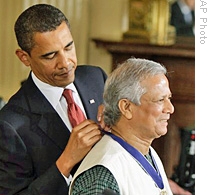
President Barack?Obama?places a 2009 Presidential Medal of Freedom around the neck of Muhammad Yunus, Wednesday, Aug. 12, 2009, during a ceremony in the East Room of the White House in Washington. (AP Photo/Alex Brandon)
Muhammad Yunus joins Mary Robinson, Desmond Tutu, Sidney Poitier, Billie Jean King, Edward Kennedy, Stephen Hawking and others to receive 2009 Presidential Medal of Freedom from Obama at White House
I can't quite keep up with Yunus Bhai's awards. I was there when he met Mandela in July, and he was at Drik last week for the Pathshala Graduation Day exhibition, but White House I'll pass. Great to see a Bangladeshi name in that list though.
Reza Deghati on "One on One" by Riz Khan: Al Jazeera
Earlier this month:
One on one part 1 One on one part 2 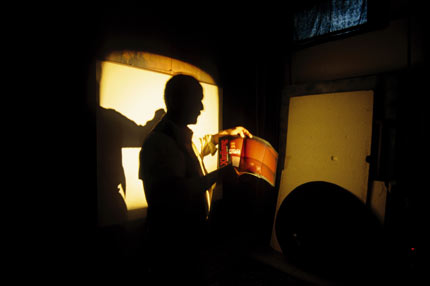 Reza Deghati, one of the most popular teachers at Pathshala has returned three times. His work has been shown at Chobi Mela. Nazrul Islam from Drik has worked as photo librarian at Aina, the agency set up by Reza in Afghanistan, as part of an exchange programme supported by the Norwegian agency Fredskorpset. ??Abir Abdullah/Drik --------------------------------------------
Reza Deghati, one of the most popular teachers at Pathshala has returned three times. His work has been shown at Chobi Mela. Nazrul Islam from Drik has worked as photo librarian at Aina, the agency set up by Reza in Afghanistan, as part of an exchange programme supported by the Norwegian agency Fredskorpset. ??Abir Abdullah/Drik --------------------------------------------
| Abbas Kiarostami – a photographic overture |
For this exhibition, launched to coincide with the opening of his production of Mozart?s Cos? fan Tutte at the?English National Opera , Abbas Kiarostami will present a series of photographic and film works that celebrate the poetry he constantly finds in inanimate things - rain, roads and trees... For Kiarostami, trees are artists, interlocutors and companions. They have remained an id?e fixe in his body of work. ?One of the earliest memories I have is driving in a car with my grandmother 30 or 40 years ago. She said, ?Look at that one.? I looked and I saw a solitary tree at the bottom of a hill. I said, ?So what about it? It?s a tree.? But she didn?t have any explanation. It?s about that. You cannot put it into words. From my very first photos when I first picked up a camera, I realised that trees had more significance for me than human beings,? he says. ?I have always quoted Ibn Arabi, who says that ?the tree is my sister?. I feel even more than this.? He will also show the short, rarely seen, film Sleepers (first shown at the Venice Biennale in 2001).
Not In Our Name
Anti war film by Hazuan Hashim and?Phil Maxwell
Very moving?..the film subtly and brilliantly contrasts the difference between destruction and creativity ? Tony Benn
Six years in the making, Hazuan Hashim and Phil Maxwell?s film examines the work of Artists Against the War. The film was shot in fourteen different countries and features footage from Iraq and the USA opening up a rich visual landscape to explore the folly of war. The screening of this specially commissioned sixty minute cut of the film will be followed by a panel discussion on the dynamics of art, film and protest. Although this is a truly international film, its roots are firmly in London with plenty of reminders of opposition to the war in the East End.? Panellists will include the film?s directors, artists Bob and Roberta Smith, May Ayres and playwright Hussain Ismail
Love in black and white - book by Michael Kenna and Bianca Rossini
Beverly Hills, CA ? World-renowned, British-born, photographer Michael Kenna and Brazilian-born Hollywood author and actress Bianca Rossini collaborated to create a book of 45 black and white photographs and poetry titled ?Love in black and white? Published by Nazraeli Press in Summer-2009. ?Love in black and white is a work of extraordinary collaborative passion? - Don Heckman. Read more: http://www.biancarossini.com/column20.pdf Watch video: http://www.youtube.com/watch?v=GAntEreiFSE
Israel, Palestine and the Hypocrisies of Power ? an interview with Noam Chomsky
In the course of an interview given to the Lambeth and Wandsworth (London) branch of the Palestine Solidarity Campaign in July 2007, the celebrated American intellectual and activist Noam Chomsky provided a devastating insight into what lies behind the continuing conflict - and could lead to the death of the Palestinian nation itself, if the ?rejectionists? are allowed to prevail against overwhelming public opinion, East and West.
What is your view of the situation in Gaza today? Could it mark the beginning of the end for the Palestinian Authority?
Some background is necessary. Let?s begin with January 2006, when Palestinians voted in a carefully monitored election, pronounced to be free and fair by international observers - despite US efforts to swing the election towards their favourite, Mahmoud Abbas and his Fatah party. But Palestinians committed a grave crime, by Western standards. They voted ?the wrong way?. The US instantly joined Israel in punishing Palestinians for their misconduct, with Europe toddling along behind as usual. There is nothing novel about the reaction to these Palestinian misdeeds. Though it is obligatory to hail our leaders for their sincere dedication to bringing democracy to a suffering world - perhaps in an excess of idealism - the more serious scholar/advocates of the mission of ?democracy promotion? recognize that there is a ?strong line of continuity? running through all administrations: the US supports democracy if, and only if, it conforms to US strategic and economic interests (Thomas Carothers, head of the Law and Democracy Program of the Carnegie Endowment). In short, the project is pure cynicism, if viewed honestly. The US project should be described as one of blocking democracy, not promoting it - dramatically so in the case of Palestine. The punishment of Palestinians for the crime of voting the wrong way was severe. With constant US backing, Israel increased its violence in Gaza, withheld funds that it was legally obligated to transmit to the Palestinian Authority, tightened its siege and, in a gratuitous act of cruelty, even cut off the flow of water to the arid Gaza Strip. The Israeli attacks became far more severe after the capture of Corporal Gilad Shalit on 25 June, which the West portrayed as a terrible crime. Again, pure cynicism. Just one day before, Israel kidnapped two civilians in Gaza ? a far worse crime than capturing a soldier ? and transported them to Israel (in violation of international law, but that is routine), where they presumably joined the roughly 1,000 prisoners held by Israel without charges, hence kidnapped. None of this merits more than a yawn in the West. There is no need here to run through the ugly details. The US-Israel made sure that Hamas would not have a chance to govern. Of course, the two leaders of the rejectionist camp flatly rejected Hamas?s call for a long-term cease-fire to allow for negotiations for a settlement in terms of the international consensus on a two-state settlement, which the US-Israel reject - as they have done in virtual isolation for over 30 years, with rare and temporary departures.
Meanwhile, Israel stepped up its programmes of annexation, dismemberment and imprisonment of shrinking Palestinian cantons in the West Bank, always with decisive US backing, despite occasional minor complaints accompanied by the wink of an eye and munificent funding. The programmes were formalized in Prime Minister Ehud Olmert?s ?convergence programme?, which spells the end of any viable Palestinian state. His programme was greeted in the West with much acclaim as ?moderate?, because it did not satisfy the demands of ?greater Israel? extremists. It was soon abandoned as ?too moderate?, again with understanding - if mild - notes of disapproval by Western hypocrites. There is a standard operating procedure for overthrowing an unwanted government: arm the military to prepare for a military coup. The US-Israel adopted this conventional plan, arming and training Fatah to win by force what it lost at the ballot box. The US also encouraged Mahmoud Abbas to amass power in his own hands - steps that are quite appropriate in the eyes of Bush administration advocates of presidential dictatorship. As for the rest of the Quartet, Russia has no principled objection to such steps, the UN is powerless to defy the Master and Europe is too timid to do so. Egypt and Jordan supported the effort, consistent with their own programmes of internal repression and barring of democracy, with US backing. The strategy backfired. Despite the flow of military aid, Fatah forces in Gaza were defeated in a vicious and brutal conflict, which many close observers describe as a pre-emptive strike, targeting primarily the security forces of the brutal Fatah strongman Mohammed Dahlan (Alistair Crooke, Jonathan Steele, and others). However, those with overwhelming power can often snatch victory from the jaws of defeat, and the US-Israel quickly moved to turn the outcome to their benefit. They now have a pretext for tightening the stranglehold on the people of Gaza, cheerfully pursuing policies that the prominent international law scholar Richard Falk describes as a prelude to genocide that ?should remind the world of the famous post-Nazi pledge of ?never again??. The US-Israel can pursue the project with international backing, unless Hamas meets the three conditions imposed by the ?international community? - a technical term referring to the US Government and whoever goes along with it. For Palestinians to be permitted to peek out of the walls of their Gaza dungeon, Hamas must: (1) recognize Israel or, in a more extreme form, Israel?s ?right to exist? - that is, the legitimacy of their expulsion from their homes; (2) renounce violence; (3) accept past agreements - in particular, the Road Map of the Quartet. The hypocrisy again is stunning. No such conditions are imposed on those who wear the jackboots: (1) Israel does not recognize Palestine, in fact is devoting extensive efforts to ensure that there will be no viable Palestine ever, always with decisive US support; (2) Israel does not renounce violence - and it is ridiculous even to raise the question with regard to the US; (3) Israel firmly rejects past agreements, in particular, the Road Map, with US support. The first two points are obvious. The third is correct, but scarcely known. While Israel formally accepted the Road Map, it attached 14 Reservations that completely eviscerate it. To take just the first, Israel demanded that for the process to commence and continue, the Palestinians must ensure full quiet, education for peace, cessation of incitement, dismantling of Hamas and other organizations, and other conditions. Even if they were to satisfy these virtually impossible demands, the Israeli Cabinet proclaimed that ?the Roadmap will not state that Israel must cease violence and incitement against the Palestinians?. The other reservations continue in the same vein. Israel?s instant rejection of the Road Map, with US support, is unacceptable to the Western self-image, so it has been suppressed. The facts did finally break into the mainstream with the publication of Jimmy Carter?s Palestine: Peace Not Apartheid. The book elicited a torrent of abuse and desperate efforts to discredit it, but these sections ? the only part of the book that would have been new to readers with some familiarity with the topic ? were scrupulously avoided. It would, rightly, be considered utterly ludicrous to demand that a political party in the US or Israel meet such conditions - though it would be fair to ask that the two states with overwhelming power meet them. But the imperial mentality is so deeply embedded in Western culture that this travesty passes without criticism, even notice. While now in a position to crush Gaza with even greater cruelty, Israel can also proceed, with US backing, to implement its plans in the West Bank, expecting to have the tacit co-operation of Fatah leaders, who will be amply rewarded for their capitulation. Among other steps, Israel began to release the funds ? estimated at $600 million ? that it had stolen in reaction to the January 2006 election, and is making a few other gestures. The programmes of undermining democracy are proceeding with shameless self-righteousness and ill-concealed pleasure, with gestures to keep the natives contented ? at least those who play along - while Israel continues its merciless repression and violence ; and, of course, its immense projects to ensure that it will take over whatever is of value to it in the West Bank. All thanks to the benevolence of the gracious rich uncle. To turn, finally, to your question ; the end of the Palestinian Authority might not be a bad idea for Palestinians, in the light of US-Israeli programmess of rendering it nothing more than a quisling regime to oversee their extreme rejectionist designs. What should concern us much more is that US-Israeli triumphalism - and European cowardice - might be the prelude to the death of a nation, a rare and somber event.

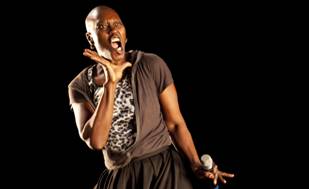
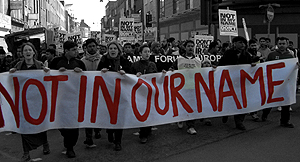
One thought on “Things friends have been up to”
Comments are closed.